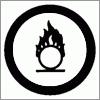If there is a chemical spill, immediately:
- Evacuate the immediate area
- Call security (2400) and report the location, injuries, chemical name, hazards, and amount of the spill. Request medical assistance if required.
- Isolate the area, prevent re-entry and wait for assistance. Get a copy of the appropriate MaterialSafety Data Sheet from your area file or master file in Facilities Services (Coquitlam) and Room 4800 (New Westminster).
If the spill is toxic, corrosive or larger volume (greater than 4 litres), the building may require evacuation. Once the decision has been made, the fire alarm will be activated and everyone must leave. If possible, give a copy of the MSDS to the emergency response team.
For minor spills, barricade the area, wear appropriate protective equipment, contain the spill with Kitty Litter or Spill Kit absorbent, or a boom to form a dike around the spill and call Security at 2400 for assistance. Transfer the material to a suitable container and label as hazardous waste. Assistance for minor spills is also available by calling Facilities Services at 5400 or Chemistry (spill cart) at 5240 (New Westminster) or 6262 (Coquitlam).
If the spill is outside the college building or involves transportation, notify Security at 2400 or dial 911 if calling from outside of Douglas College. They can reach Canadian Transport Emergency Center, Canutec, at 1- (613) 996 6666.
Accidental discharges of hazardous materials into drains, and other water courses and the air must be reported to Facilities Services. Details of reportable quantities can be obtained from the Health and Safety office, local 6337.
Be prepared! Read MSDSs for the products you handle and make sure you have supplies and protective equipment available to deal with minor spills in your area. Make sure that you are familiar with WHMIS symbols and the risks they represent.
Workplace Hazardous Materials Information System

| Class A Compressed Gas |

| Class B Flammable and Combustible Material |

| Class C Oxidizing Material |

| Class D Poisonous and Infectious Material Division 1 Materials Causing Immediate and Serious Toxic Effects |

| Class D Poisonous and Infectious Material Division 2 Materials Causing Other Toxic Effects |

| Class D Poisonous and Infectious Material Division 3 Biohazardous Infectious Material |

| Class E Corrosive Material |

| Class F Dangerously Reactive Material |